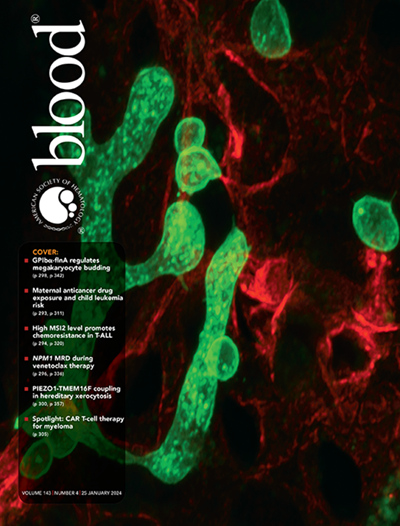利用空间转录组学分析人类骨髓环肺活检标本中多发性骨髓瘤的空间结构。
IF 21
1区 医学
Q1 HEMATOLOGY
引用次数: 0
摘要
骨髓微环境与支撑多发性骨髓瘤发展和进展的生物学密切相关。然而,形成骨髓壁龛的复杂细胞和分子特征尚未明确。在这里,我们使用亚细胞空间转录组学来分析多发性骨髓瘤患者骨髓中5,001个基因的表达。利用这种方法,我们研究了21例患者骨髓环环内的浆细胞和基质生态系统,其中包括7例恶性前病变患者和10例新诊断的多发性骨髓瘤患者。利用空间转录组学与优化的环磷石生物银行方法相结合,我们可以解决人类骨髓微环境的主要组成部分,并可靠地表征来自健康、恶性前期疾病和活动力骨髓瘤样本中不同的浆细胞群。当浆细胞在位置背景下可视化时,我们在10个新诊断的骨髓瘤环瘤中检测到5个空间限制的浆细胞亚群。令人惊讶的是,造血和基质微环境的组成在新诊断的骨髓瘤之间有显著差异。此外,在具有空间限制浆细胞亚群的环甲鱼体内也观察到这些微环境的差异。因此,这些数据与普遍的骨髓微环境支持骨髓瘤恶性浆细胞扩张的假设不一致。相反,我们认为骨髓瘤亚群形成了不同的微环境,并且可以在患者和空间位置之间变化。本文章由计算机程序翻译,如有差异,请以英文原文为准。
Profiling the spatial architecture of multiple myeloma in human bone marrow trephine biopsy specimens with spatial transcriptomics.
The bone marrow microenvironment is intimately linked to the biology that underpins the development and progression of multiple myeloma. However, the complex cellular and molecular features that form bone marrow niches are poorly defined. Here, we used subcellular spatial transcriptomics to profile the expression of 5,001 genes in human bone marrow in the context of multiple myeloma. Using this approach, we explored the plasma cell and stroma ecosystem in bone marrow trephines from 21 individuals, including 7 with pre-malignant disease and 10 with newly diagnosed multiple myeloma. Using spatial transcriptomics in conjunction with an optimised trephine biobanking methodology, we could resolve major components of the human bone marrow microenvironment and reliably characterise distinct plasma cell populations in samples from healthy, pre-malignant disease and active myeloma. When plasma cells were visualised in the context of location, we detected spatially restricted subpopulations of plasma cells in five of ten newly diagnosed myeloma trephines. Surprisingly, the composition of haematopoietic and stromal microenvironments varied significantly between newly diagnosed myeloma trephines. Furthermore, these differences in microenvironments were also observed within trephines that had spatially restricted plasma cell subpopulations. Thus, these data are not consistent with the hypothesis that a universal bone marrow microenvironment supports the expansion of malignant plasma cells in myeloma. Instead, we propose that myeloma subpopulations form distinct microenvironments and can vary between both patients and spatial location.
求助全文
通过发布文献求助,成功后即可免费获取论文全文。
去求助
来源期刊

Blood
医学-血液学
CiteScore
23.60
自引率
3.90%
发文量
955
审稿时长
1 months
期刊介绍:
Blood, the official journal of the American Society of Hematology, published online and in print, provides an international forum for the publication of original articles describing basic laboratory, translational, and clinical investigations in hematology. Primary research articles will be published under the following scientific categories: Clinical Trials and Observations; Gene Therapy; Hematopoiesis and Stem Cells; Immunobiology and Immunotherapy scope; Myeloid Neoplasia; Lymphoid Neoplasia; Phagocytes, Granulocytes and Myelopoiesis; Platelets and Thrombopoiesis; Red Cells, Iron and Erythropoiesis; Thrombosis and Hemostasis; Transfusion Medicine; Transplantation; and Vascular Biology. Papers can be listed under more than one category as appropriate.
 求助内容:
求助内容: 应助结果提醒方式:
应助结果提醒方式:


